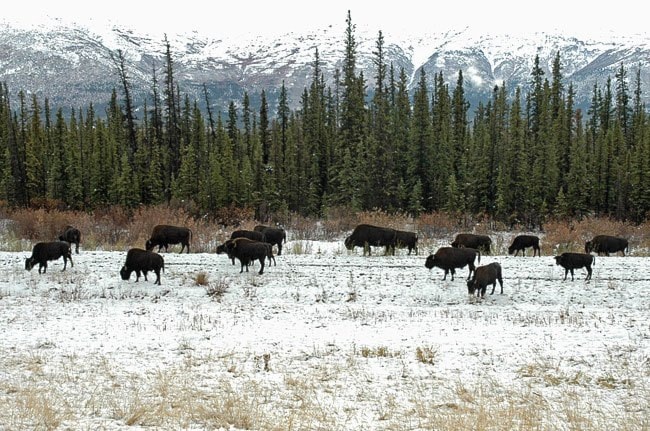Yukon’s Aishihik bison herd is still going strong, and that’s actually a bit of a problem.
The bison-hunting season has closed for the season, and with 136 animals harvested, the herd is still estimated to be around 1,200 animals.
That’s about 200 higher than the territory’s bison management team would like it, said biologist Tom Jung.
The team would like to see about 150 animals taken each year, he said. With those numbers over the five-year life of the plan, they hope to get the herd down to its target of 1,000.
“If it was caribou, we’d say it was too many, but we’re trying to bring the herd down,” he said.
“It’s not quite where we’d like it to be, but that’s still a lot of meat in people’s freezers.”
The 1,000-animal target is designed to ensure the long-term viability of the herd and ensure there are enough animals for Yukoners to harvest sustainably. The management team is made up of representatives from Environment Yukon, the hunting community and affected First Nations. The herd’s target size is also meant to help reduce human-bison conflicts like collisions on the highway and to keep the herd contained within a defined boundary.
While Jung said the plan does call for more hunting generally, it’s actually more important that people start targeting more cows.
This year, there were 55 cows killed and 81 bulls. That’s about a 40-60 per cent split, Jung said. He wants to see it closer to 50-50.
It’s essentially the opposite of a conservation plan, where hunting is restricted and killing females is strongly discouraged.
Taking a cow will be more effective in terms of reducing the herd size than killing a bull, and they also taste better, Jung said.
“The bulls aren’t really the best eating. They tend to be older and tougher. Most people don’t have a need for that much hamburger meat,” he said.
In recent years the government has tried to get more hunters to go after bison. It reduced the price of a bison seal to $10 and got rid of the lottery for a permit. There were 900 such permits issued this year, but only a fraction of those turned into actual kills.
“We believe we’ve done a lot to liberalize the hunt, but we do still have some barriers,” Jung said.
That includes harsh winter weather, and the bison themselves. The season doesn’t open until November. Heavy snow, frigid temperatures and easier access to other game make for some serious disincentives.
Plus, since being reintroduced in the 1980s, the animals have learned to be wary of humans, and can be very difficult to find, Jung said. Making it more challenging, cows and calves are even wilier than the bulls, which accounts for some of the gender discrepancy.
There are about a half-dozen other so-called conservation herds in Canada, including many animals in the Northwest Territories, Jung said.
The bison were introduced in the early 1980s. One hundred and forty-one animals were brought to the Yukon, mostly from Elk Island in Alberta, Jung explained.
They were kept in a pen until 1988, when 170 were released into the wild, and have thrived in the area around Haines Junction.
Contact Jesse Winter at
jessew@yukon-news.com
